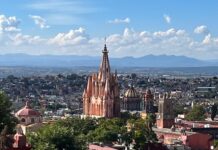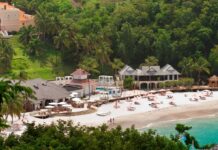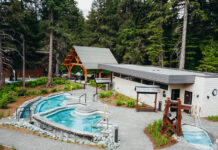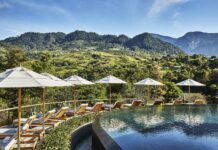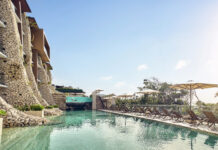by Anne Dimon,
From the cruise ship docking station, it’s a long, bumpy ride into downtown Yangon, Myanmar. The distance is just 21 miles but with the traffic – bumper-to-bumper taxis, local buses, private cars and mini vans – it takes us over an hour on the complimentary, air-conditioned shuttle provided by Crystal. The Shwedagon Pagoga is definately worth the trip.

Formerly known as Burma, Myanmar is bordered by China, Thailand and India and, as we learn via an onboard lecture by destination expert Joe Snyder, a 30-year diplomat with the U.S. Department of State’s Foreign Service, the country was once part of British India, it gained independence in 1948, it’s just slightly smaller than Texas and its population is 89% Buddhist.
It’s Monday about 5 p.m. when we arrive and the pagoda is crowded with visitors. Cost to enter is $9 U.S. per person plus an additional charge of $5 for a loan of the batik wrap I am told I must wear. While my shoulders and arms are draped with a light scarf, my modest knee length skirt is considered inappropriate attire (knees must be covered). Another rule to be observed by pilgrims and visitors – no shoes or socks are allowed past the front entrance. Everyone goes barefoot on the tiled flooring warmed by the sun.
 For an extra $15 U.S. we hire an English-speaking guide by the name of Soe Ni Htun (pictured with me on the left). Soe (pronounced Sue) tells us that in his country there is no ‘last’ name or ‘family’ name, and children are named depending on the day they were born. Each day, he says has specific letters attached to it and it is from those letters that a name derives. Soe was born on a Tuesday.
For an extra $15 U.S. we hire an English-speaking guide by the name of Soe Ni Htun (pictured with me on the left). Soe (pronounced Sue) tells us that in his country there is no ‘last’ name or ‘family’ name, and children are named depending on the day they were born. Each day, he says has specific letters attached to it and it is from those letters that a name derives. Soe was born on a Tuesday.
An archeologist by trade, he tells us that the site of the Shwedagon Pagoda dates back over 2,600 years to the time when a 28-meter gold stupa was erected to hold eight strands of hair from Buddha’s head.
The original stupa was damaged in an earthquake, and rebuilt over 240 years ago. The gold plated structure towers 98.8 feet above the ground and is topped by a jewel encrusted cap said to be worth more than a king’s fortune. When I visit on March 2, 2015 the bottom half of the stupa was covered in scaffolding but it was still an imposing sight.
A ‘stupa,’ we learn, is a tall solid structure with no access to the inside, while a temple is a hollow structure that one may enter to meditate.
Shwedagon Pagoda, as it stands today, is the size of a small town over 114 acres, encompassing 380 stupas and temples, plus 1004 images and statues of Buddha.
Soe explains that stupas are built for one of three reasons: to hold relics of Buddha, to hold relics of worthy Buddhist monks, or to mark a sacred spot.
The soundtrack here is the constant chanting of a sole monk. Soe explains that during this Annual Festival (which takes place at the end of February, early March) the chanting must go on non-stop for 11 days straight so the monks take their turns – one per monk per hour takes to the airwaves. A fascinating looking into a unique culture.



